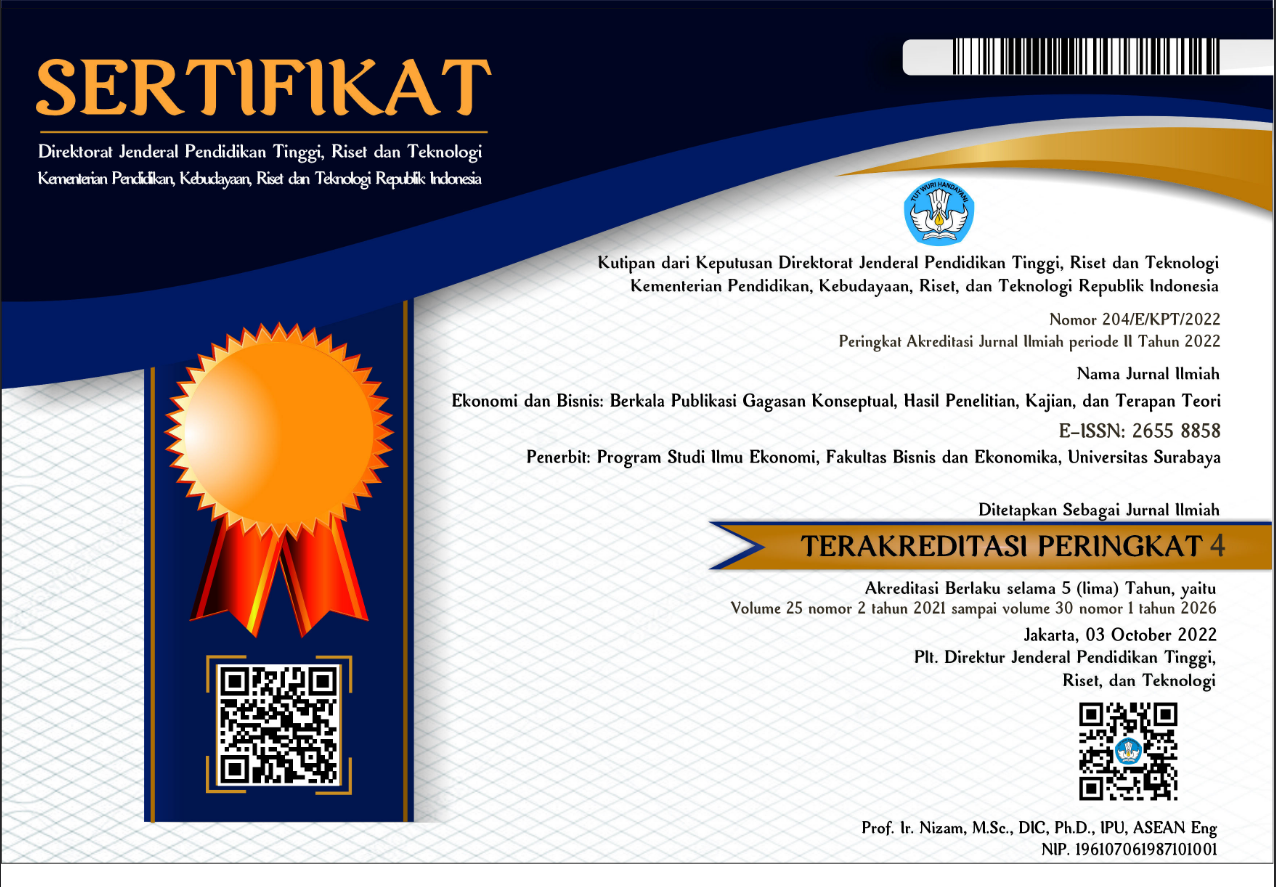PENGARUH TINGKAT BUNGA DAN PENDAPATAN NASIONAL TERHADAP TABUNGAN DI INDONESIA, MALAYSIA DAN THAILAND
 Abstract Views:
902 times
Abstract Views:
902 times
 PDF Downloads:
1641 times
PDF Downloads:
1641 times
Abstract
The purpose of the study: 1 Testing the effect of interest rates in the short term and the long-term domestic savings in Indonesia, Malaysia and Thailand. 2 Testing the influence of national income in the short term and the long-term domestic savings in Indonesia, Malaysia and Thailand. Analysis tool is a dynamic econometric model of the Partial Adjustment Model (PAM). This model applies when the independent variable is the lag of the dependent variable and must be positive and statistically significant. The results of the analysis as follows: 1. For Indonesia, short-term and long-term national income significantly influence domestic savings 2. For Indonesia, the short-term and long-term interest rate has no significant effect on domestic savings. 3. For Malaysia, the national income in the short term a significant effect on domestic savings, but can not be used long-term model. 4. For Malaysia, the short-term interest rates have a significant effect on domestic savings, but can not be used long-term model. 5. For Thailand, in the short-term and long-term national income no significant effect on domestic savings. 6. For Thailand, in the short term and long term interest rates have a significant effect on domestic savings.
Downloads
References
Adi Lumadya, 2002, Faktor-faktor yang Mempengaruhi Tabungan Domestik di Indonesia Tahun 1975 -1997 (Pendekatan: Error Correction Model) , Jurnal Riset Ekonomi dan Manajemen, vol.2 No.1, hal 16 - 33
Asfia Murni, 2006, Ekonomika Makro, Aditama
Asian Development Bank, 2012, Key Indicators for Asian and The Pasific Countries.
Bambang Kustituanto dan Istiqomah, 1999, Peranan Modal Asing (PMA) terhadap Pertumbuhan Ekonomi di Indonesia, Jurnal Ekonomi dan Bisnis Indonesia, Vol. 14 No.2, Fakultas Ekonomi Universitas Gadjah Mada, hal 1 – 13.
Bela Balassa,1989,Outward Orientation, Handbook of DevelopmentEconomies, Vol.II,Edited by H. Cheneryy and TN.Srinivasan:Elsevier science Publisher B.V,1646 – 89.
Damodar N Gujarati, 1995,Basic Econometries, Third Edition, McGraw-Hill Book Co, Singapore.
Eugene A.Diulio,1993, Uang dan Bank, Penerbit Erlangga
GeraldM, Meier, 1995, Louding Issues in Economic Development, Sixth Edision: Oxford University Press, N.Y.
Insukindro, 1999, Pemilihan Model Ekonomi Empirik dengan Pendekatan Koreksi Kesalahan, Journal Ekonomi dan Bisnis Indonesia, Vol.14 No.1, Fakultas Ekonomi Universitas Gadjah Mada.
Insukindro, 2000, Pelatihan Ekonomika Dasar, Modul, Kerjasama antara Program Magister Ekonomika Pembangunan Universitas Gadjah Mada.
Insukindro, 2001, Pelatihan Metodologi Empiris: Ekonometrika Model Dinamis, Modul, PAU-Studi Pembangunan, 25 -29 Juni, Universitas Gadjah Mada.
Jonathan Eathon, 1989, Foreign Public Capital Flows, Handbook of Developing Economics, Vol.II, Edited by H.Chenery and TN Srinivasan: Elsevier Science Publisher B.V.1306-85.

 DOI:
DOI:















